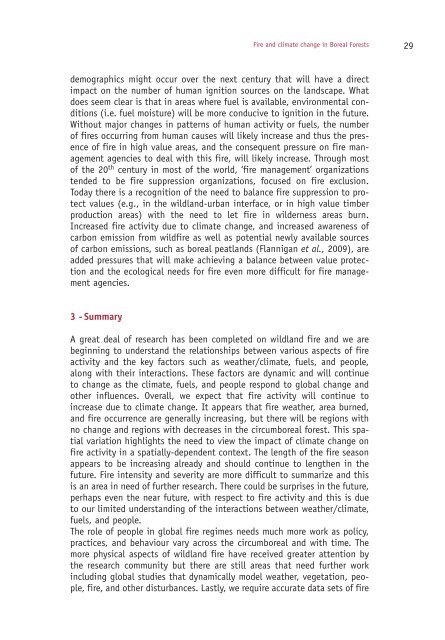7th Workshop on Forest Fire Management - EARSeL, European ...
7th Workshop on Forest Fire Management - EARSeL, European ...
7th Workshop on Forest Fire Management - EARSeL, European ...
You also want an ePaper? Increase the reach of your titles
YUMPU automatically turns print PDFs into web optimized ePapers that Google loves.
<strong>Fire</strong> and climate change in Boreal <strong>Forest</strong>s 29<br />
demographics might occur over the next century that will have a direct<br />
impact <strong>on</strong> the number of human igniti<strong>on</strong> sources <strong>on</strong> the landscape. What<br />
does seem clear is that in areas where fuel is available, envir<strong>on</strong>mental c<strong>on</strong>diti<strong>on</strong>s<br />
(i.e. fuel moisture) will be more c<strong>on</strong>ducive to igniti<strong>on</strong> in the future.<br />
Without major changes in patterns of human activity or fuels, the number<br />
of fires occurring from human causes will likely increase and thus the presence<br />
of fire in high value areas, and the c<strong>on</strong>sequent pressure <strong>on</strong> fire management<br />
agencies to deal with this fire, will likely increase. Through most<br />
of the 20 th century in most of the world, ‘fire management’ organizati<strong>on</strong>s<br />
tended to be fire suppressi<strong>on</strong> organizati<strong>on</strong>s, focused <strong>on</strong> fire exclusi<strong>on</strong>.<br />
Today there is a recogniti<strong>on</strong> of the need to balance fire suppressi<strong>on</strong> to protect<br />
values (e.g., in the wildland-urban interface, or in high value timber<br />
producti<strong>on</strong> areas) with the need to let fire in wilderness areas burn.<br />
Increased fire activity due to climate change, and increased awareness of<br />
carb<strong>on</strong> emissi<strong>on</strong> from wildfire as well as potential newly available sources<br />
of carb<strong>on</strong> emissi<strong>on</strong>s, such as boreal peatlands (Flannigan et al., 2009), are<br />
added pressures that will make achieving a balance between value protecti<strong>on</strong><br />
and the ecological needs for fire even more difficult for fire management<br />
agencies.<br />
3 - Summary<br />
A great deal of research has been completed <strong>on</strong> wildland fire and we are<br />
beginning to understand the relati<strong>on</strong>ships between various aspects of fire<br />
activity and the key factors such as weather/climate, fuels, and people,<br />
al<strong>on</strong>g with their interacti<strong>on</strong>s. These factors are dynamic and will c<strong>on</strong>tinue<br />
to change as the climate, fuels, and people resp<strong>on</strong>d to global change and<br />
other influences. Overall, we expect that fire activity will c<strong>on</strong>tinue to<br />
increase due to climate change. It appears that fire weather, area burned,<br />
and fire occurrence are generally increasing, but there will be regi<strong>on</strong>s with<br />
no change and regi<strong>on</strong>s with decreases in the circumboreal forest. This spatial<br />
variati<strong>on</strong> highlights the need to view the impact of climate change <strong>on</strong><br />
fire activity in a spatially-dependent c<strong>on</strong>text. The length of the fire seas<strong>on</strong><br />
appears to be increasing already and should c<strong>on</strong>tinue to lengthen in the<br />
future. <strong>Fire</strong> intensity and severity are more difficult to summarize and this<br />
is an area in need of further research. There could be surprises in the future,<br />
perhaps even the near future, with respect to fire activity and this is due<br />
to our limited understanding of the interacti<strong>on</strong>s between weather/climate,<br />
fuels, and people.<br />
The role of people in global fire regimes needs much more work as policy,<br />
practices, and behaviour vary across the circumboreal and with time. The<br />
more physical aspects of wildland fire have received greater attenti<strong>on</strong> by<br />
the research community but there are still areas that need further work<br />
including global studies that dynamically model weather, vegetati<strong>on</strong>, people,<br />
fire, and other disturbances. Lastly, we require accurate data sets of fire
















